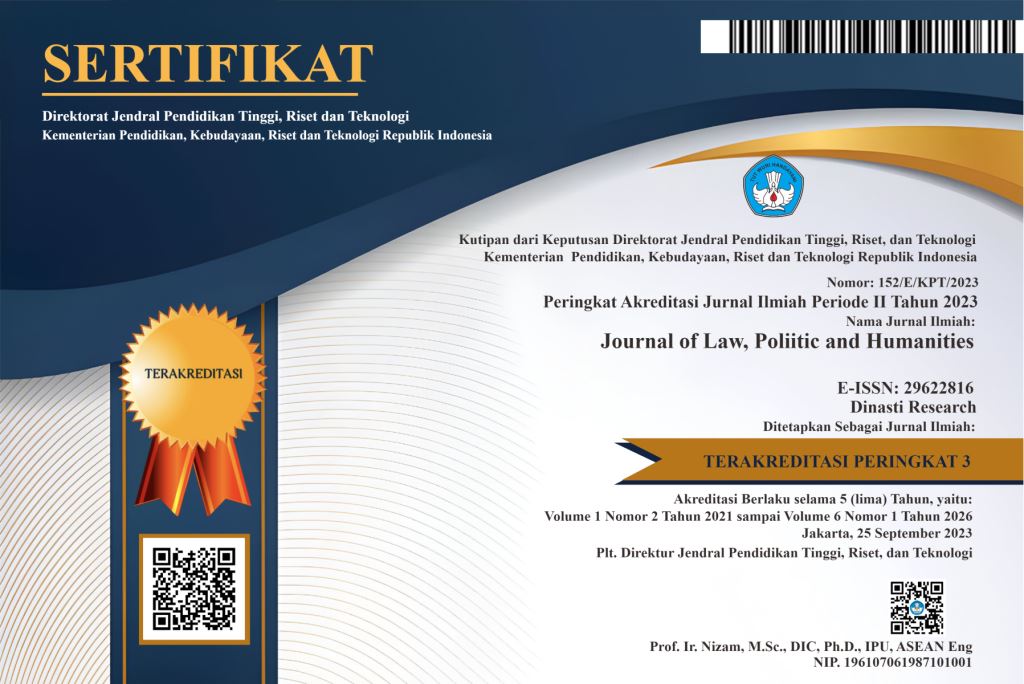Legal Analysis of the Validity of E-Stamps in the Creation of Notarial Deeds and PPAT Deeds Based on the Stamp Duty Law and the Notary Position Law
DOI:
https://doi.org/10.38035/jlph.v5i5.1921Keywords:
E-Stamp, Authentic Deed, Notary, PPAT, Legal Certainty, Document DigitizationAbstract
The development of digital technology has driven transformation in various fields, including the administration system and legal proof through documents. One significant innovation is the implementation of electronic stamps (e-stamps) as an alternative to physical stamps based on Law No. 10 of 2020 on Stamp Duty. E-stamps offer efficiency, ease of access, and the potential to prevent document forgery. However, its application in authentic deeds made by Notaries and Land Deed Officials (PPAT) raises legal questions, particularly concerning its validity and legal certainty. Article 1868 of the Civil Code (KUH Perdata) stipulates that authentic deeds must be made by or before a public official in accordance with the form specified by law. Meanwhile, the Notary Position Law has not explicitly accommodated the use of e-stamps. This research uses a normative approach with doctrinal and legislative methods to analyze the compatibility of e-stamp usage in authentic deeds. The study's findings show that although substantively e-stamps are valid as a tool for collecting duties, there is a legal gap in the technical regulations concerning their use in notarial and PPAT deeds. This gap creates legal uncertainty that may affect the evidentiary power of authentic deeds in court. Therefore, there is a need for more harmonious regulations and clear technical guidelines so that the digital transformation in notarial practices can be effectively implemented without reducing legal certainty.
References
Abbas, I., & Putra, A. H. P. K. (2024). Utilitarianism Perspective on The Use of E-Stamps in Business Practices in Indonesia. Jurnal IUS Kajian Hukum Dan Keadilan, 12(1), 224–236.
Amayaffa, A. A., Pribadi, D. S., & Wardana, K. W. (2024). Analisis Hukum dalam Penggunaan E-Materai di Kantor Notaris/Pejabat Pembuat Akta Tanah (PPAT). As-Syar’i: Jurnal Bimbingan & Konseling Keluarga, 6(3), 1896–1911.
Halilah, S., & Arif, M. F. (2021). Asas Kepastian Hukum Menurut Para Ahli. Siyasah: Jurnal Hukum Tata Negara, 4(II).
Hasanah, U., Husna, H., & Haris, M. (2024). Keabsahan Meterai Elektronik Pada Akta Otentik Di Notaris. SULTAN ADAM: Jurnal Hukum Dan Sosial, 2(1), 108–114.
Intansari, O., & Ratna, E. (2022). Keotentikan Akta Pejabat Pembuat Akta Tanah Elektronik. Notarius, 16(2), 916–922.
Julyano, M., & Sulistyawan, A. Y. (2019). Pemahaman terhadap asas kepastian hukum melalui konstruksi penalaran positivisme hukum. Crepido, 1(1), 13–22.
Kalesaran, F. (2022). Analisis Yuridis Terhadap Meterai Elektronik Ditinjau Dari Undang-Undang Nomor 10 TahuN 2020. Lex Privatum, 10(4).
Montolalu, M. J. (2025). KEDUDUKAN METERAI ELEKTRONIK DALAM SEBUAH PERJANJIAN DI TINJAU DARI PERATURAN PEMERINTAH NOMOR 86 TAHUN 2021 TENTANG PENGADAAN, PENGELOLAAN DAN PENJUALAN METERAI. LEX PRIVATUM, 14(5).
Nasir, G. A. (2017). Kekosongan Hukum & Percepatan Perkembangan Masyarakat. JHR (Jurnal Hukum Replik), 5(2), 172–183.
Nugraha, S. (2024). Metode Penelitian Hukum. Ruang Karya Bersama. https://book.ruangkarya.id/views/shop-single.php?id=6936abe4-f328-11ee-8115-0904a7ab83ff
Pramono, D. (2015). Kekuatan pembuktian akta yang dibuat oleh notaris selaku pejabat umum menurut hukum acara perdata di Indonesia. Lex Jurnalica, 12(3), 147736.
Utami, A. (2023). ANALISIS HUKUM PENERAPAN PRINSIP KEHATI-HATIAN (PRUDENTIAL PRINCIPLE) NOTARIS DALAM PEMBUATAN AKTA AUTENTIK. Universitas Muslim Indonesia.
Wahyuni, W. (2022). Akta Autentik dan Akta di Bawah Tangan. Https://Www.Hukumonline.Com/. https://www.hukumonline.com/berita/a/akta-autentik-dan-akta-di-bawah-tangan-lt63a2eaabaf2db/
Wibowo, K. Z., & Hartanto, G. (2025). Implications Of The Use Of E-Stalls On The Binding Force In Proof Of Electronic Agreements. Jurnal Hukum Sehasen, 11(1), 261–270.
Downloads
Published
How to Cite
Issue
Section
License
Copyright (c) 2025 Jesika Ananda Putri, Thea Farina, Andika Wijaya

This work is licensed under a Creative Commons Attribution 4.0 International License.
Authors who publish their manuscripts in this journal agree to the following conditions:
- The copyright on each article belongs to the author(s).
- The author acknowledges that the Journal of Law, Poliitic and Humanities (JLPH) has the right to be the first to publish with a Creative Commons Attribution 4.0 International license (Attribution 4.0 International (CC BY 4.0).
- Authors can submit articles separately, arrange for the non-exclusive distribution of manuscripts that have been published in this journal into other versions (e.g., sent to the author's institutional repository, publication into books, etc.), by acknowledging that the manuscript has been published for the first time in the Journal of Law, Poliitic and Humanities (JLPH).


























